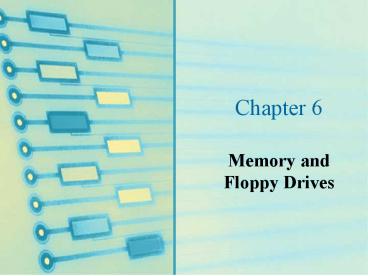Memory and Floppy Drives PowerPoint PPT Presentation
1 / 48
Title: Memory and Floppy Drives
1
Chapter 6
- Memory and Floppy Drives
2
You Will Learn
- About the different kinds of physical memory and
how they work - How to upgrade and troubleshoot memory
- How floppy drives work and how to support them
3
Physical Memory
- ROM
- RAM
- Static RAM (SRAM)
- Dynamic RAM (DRAM)
4
Dynamic RAM
5
ROM on the Motherboard
6
ROM on the Motherboard
- ROM chips (firmware)
- EPROM
- EEPROM (flash ROM chips)
7
RAM on the Motherboard
8
Static RAM Technologies
- Synchronous SRAM
- Burst SRAM
- Pipelined burst SRAM
- Asynchronous SRAM
9
How SRAM Is Used in Different Memory Caches
10
How Memory Caching Works
11
SRAM on the Motherboard
12
Dynamic RAM Technologies
- SIMMs (single inline memory modules)
- DIMMs (dual inline memory modules)
- RIMM modules (inline memory modules manufactured
by Rambus, Inc.)
13
DRAM Technologies
14
DIMMs
15
RIMMs
16
Comparison of Data Throughput of Memory
Technologies
17
Parity and Error Checking
18
Upgrading Memory
- What to look for when buying memory chips and
modules - How much and what kind of memory to buy
19
What to Look for When Buying Memory Chips and
Modules
- Use fastest memory motherboard can support
- Match tin leads to tin connectors and gold leads
to gold connectors - Date stamps on remanufactured and used modules
should be relatively close together - Beware re-marked chips
20
How Much and What Kind of Memory to Buy
- Use type, size, density, and speed of memory the
motherboard supports - Match memory modules already installed
21
How Much and What Kind of Memory to Buy
22
Installing Memory SIMM
23
Installing Memory DIMM
24
Installing Memory DIMM
25
Troubleshooting Memory
- Computer does not recognize new SIMMs, DIMMs, or
RIMMs, or memory error messages appear - Memory errors occur during normal operation, and
you have not just upgraded memory
26
Floppy Drives
- How data is storedphysically and logically
- How to manage the data
- How to install a floppy disk drive on a PC
27
Physical Data Storage on a Floppy Disk
- Disk must be formatted process of marking
tracks and sectors to prepare disk to receive data
28
Floppy Drive Subsystem
29
Tracks and Sectors
30
Inside a Floppy Disk Drive
31
Track Widths
32
Logical Data Storage on a Floppy
33
Formatting Process for a Floppy
- Create tracks and sectors
- Create boot record
- Create two copies of file allocation table (FAT)
- Create root directory
34
Contents of Floppy DiskBoot Record
35
The Root Directory Table
36
The Root Directory Table
37
Using Commands to Manage a Floppy Disk
- Format Drive /S /VVolumename /Q /U /Autotest
- Used to format floppy disks and logical drives
- /S option makes a drive bootable
- Chkdsk drive /F /V
- Checks drives for errors and repairs them
38
(No Transcript)
39
Using Windows to Manage a Floppy Disk
40
Replacing a Floppy Drive
- Check that computer and other peripherals are
working - Turn off computer and remove cover (Figure 6-20)
- Unplug data cable and power cable from old drive
unscrew and dismount drive (Figure 6-21) - Slide new drive into bay reconnect data cable
and power cable (Figure 6-22) - Turn computer on check setup test drive
41
Replacing a Floppy Drive
42
Replacing a Floppy Drive
43
Replacing a Floppy Drive
44
When a Floppy Disk Drive Doesnt Work
- Check physical condition of disk
- Check error messages
- Error messages in the 600 range occur when a
floppy drive does not pass the POST test - Check CMOS settings
- Check cables connected to drive
45
Common Error Messages and Their Meanings
- Non-system disk or disk error. Replace and strike
any key when ready. - Invalid or missing COMMAND.COM
- Incorrect DOS version
- Invalid Drive Specification
- Not ready reading drive A, Abort, Retry, Fail?
continued
46
Common Error Messages and Their Meanings
- General failure reading drive A, Abort, Retry,
Fail? - Track 0 bad, disk not usable
- Write-protect error writing drive A
47
Chapter Summary
- Physical memory
- ROM on the motherboard
- RAM on the motherboard
- Static RAM (SRAM)
- Dynamic RAM (DRAM)
- Upgrading, installing, and troubleshooting memory
continued
48
Chapter Summary
- Floppy drives
- How data is physically and logically stored on a
floppy disk - Formatting process
- Managing a floppy disk with commands or Windows
- Exchanging, supporting, and replacing, or adding
floppy drives - Troubleshooting floppy drives

